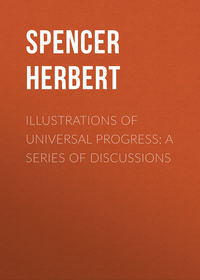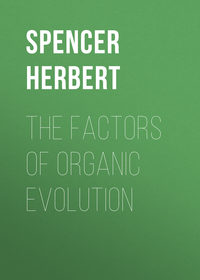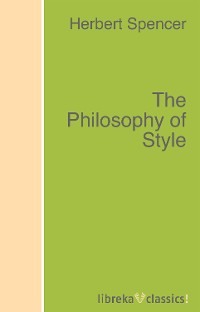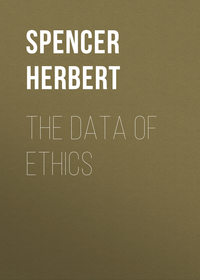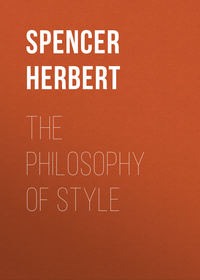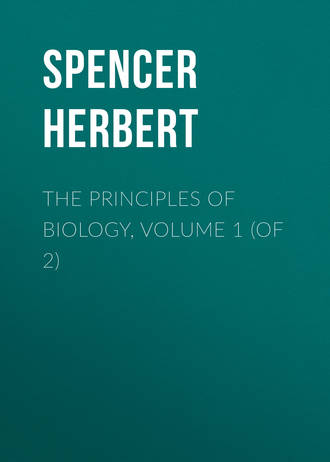 полная версия
полная версияThe Principles of Biology, Volume 1 (of 2)
Even apart from these last criticisms, however, we have clear disproof of the alleged inherent difference between the two classes of cells. Among animals, the multiplication of somatic cells is brought to an end by sundry restraining conditions; but in various plants, where these restraining conditions are absent, the multiplication is unlimited. It may, indeed, be said that the alleged distinction should be reversed; since the fissiparous multiplication of reproductive cells is necessarily interrupted from time to time by coalescence, while that of the somatic cells may go on for a century without being interrupted.
* * * * *In the essay to which this is a postscript, conclusions were drawn from the remarkable case of the horse and the quagga, there narrated, along with an analogous case observed among pigs. These conclusions have since been confirmed. I am much indebted to a distinguished correspondent who has drawn my attention to verifying facts furnished by the offspring of whites and negroes in the United States. Referring to information given him many years ago, he says: – "It was to the effect that the children of white women by a white father, had been repeatedly observed to show traces of black blood, in cases when the woman had previous connection with [i. e. a child by] a negro." At the time I received this information, an American was visiting me; and, on being appealed to, answered that in the United States there was an established belief to this effect. Not wishing, however, to depend upon hearsay, I at once wrote to America to make inquiries. Professor Cope of Philadelphia has written to friends in the South, but has not yet sent me the results. Professor Marsh, the distinguished palæontologist, of Yale, New Haven, who is also collecting evidence, sends a preliminary letter in which he says: – "I do not myself know of such a case, but have heard many statements that make their existence probable. One instance, in Connecticut, is vouched for so strongly by an acquaintance of mine, that I have good reason to believe it to be authentic."
That cases of the kind should not be frequently seen in the North, especially nowadays, is of course to be expected. The first of the above quotations refers to facts observed in the South during slavery days; and even then, the implied conditions were naturally very infrequent. Dr. W. J. Youmans of New York has, on my behalf, interviewed several medical professors, who, though they have not themselves met with instances, say that the alleged result, described above, "is generally accepted as a fact." But he gives me what I think must be regarded as authoritative testimony. It is a quotation from the standard work of Professor Austin Flint, and runs as follows: —
"A peculiar and, it seems to me, an inexplicable fact is, that previous pregnancies have an influence upon offspring. This is well known to breeders of animals. If pure-blooded mares or bitches have been once covered by an inferior male, in subsequent fecundations the young are likely to partake of the character of the first male, even if they be afterwards bred with males of unimpeachable pedigree. What the mechanism of the influence of the first conception is, it is impossible to say; but the fact is incontestable. The same influence is observed in the human subject. A woman may have, by a second husband, children who resemble a former husband, and this is particularly well marked in certain instances by the colour of the hair and eyes. A white woman who has had children by a negro may subsequently bear children to a white man, these children presenting some of the unmistakable peculiarities of the negro race."114
Dr. Youmans called on Professor Flint, who remembered "investigating the subject at the time his larger work was written [the above is from an abridgment], and said that he had never heard the statement questioned."
Some days before I received this letter and its contained quotation, the remembrance of a remark I heard many years ago concerning dogs, led to the inquiry whether they furnished analogous evidence. It occurred to me that a friend who is frequently appointed judge of animals at agricultural shows, Mr. Fookes, of Fairfield, Pewsey, Wiltshire, might know something about the matter. A letter to him brought various confirmatory statements. From one "who had bred dogs for many years" he learnt that —
"It is a well known and admitted fact that if a bitch has two litters by two different dogs, the character of the first father is sure to be perpetuated in any litters she may afterwards have, no matter how pure-bred a dog may be the begetter."
After citing this testimony, Mr. Fookes goes on to give illustrations known to himself.
"A friend of mine near this had a very valuable Dachshund bitch, which most unfortunately had a litter by a stray sheep-dog. The next year her owner sent her on a visit to a pure Dachshund dog, but the produce took quite as much of the first father as the second, and the next year he sent her to another Dachshund with the same result. Another case: – A friend of mine in Devizes had a litter of puppies, unsought for, by a setter from a favourite pointer bitch, and after this she never bred any true pointers, no matter of what the paternity was."
[Since the publication of this article additional evidences have come to hand. One is from the late Prof. Riley, State Entomologist at Washington, who says that telegony is an "established principle among well-educated farmers" in the United States, and who gives me a case in horse-breeding to which he was himself witness.
Mr. W. P. Smith, writing from Stoughton Grange, Guildford, but giving the results of his experiences in America, says that "the fact of a previous conception influencing subsequent offspring was so far recognised among American cattle-breeders" that it was proposed to raise the rank of any heifer that had borne a first calf by a thoroughbred bull, and though this resolution when brought before one of the chief societies was not carried, yet on all sides it was admitted that previous conceptions had effects of the kind alleged. Mr. Smith in another letter says: – "When I had a large mule and horse ranche in America I noticed that the foals of mares by horse stallions had a mulish appearance in those cases where the mare had previously given birth to a mule foal. Common heifers who have had calves by a thoroughbred bull are apt thereafter to have well-bred calves even from the veriest scrubs."
Yet another very interesting piece of evidence is furnished by Mr. W. Sedgwick, M.R.C.S., in an article on "The Influence of Heredity in Disease," published in the British Medical Journal for Feb. 22, 1896, pp. 460-2. It concerns the transmission of a malformation known among medical men as hypospadias. Referring to a man belonging to a family in which this defect prevailed, he writes: – "The widow of the man from whom these three generations of hypospadians were descended married again, after an interval of eighteen months; and in this instance the second husband was not only free from the defect, but there was no history of it in his family. By this second marriage she had four hypospadiac sons and four hypospadiac grandsons; whilst there were seven grandsons and three great-grandsons who were not malformed."]
Coming from remote places, from those who have no theory to support, and who are some of them astonished by the unexpected phenomena, the agreement dissipates all doubt. In four kinds of mammals, widely divergent in their natures – man, horse, dog, and pig – we have this same seemingly-anomalous kind of heredity, made visible under analogous conditions. We must take it as a demonstrated fact that, during gestation, traits of constitution inherited from the father produce effects upon the constitution of the mother; and that these communicated effects are transmitted by her to subsequent offspring. We are supplied with an absolute disproof of Professor Weismann's doctrine that the reproductive cells are independent of, and uninfluenced by, the somatic cells; and there disappears absolutely the alleged obstacle to the transmission of acquired characters.
* * * * *Notwithstanding experiences showing the futility of controversy for the establishment of truth, I am tempted here to answer opponents at some length. But even could the editor allow me the needful space, I should be compelled, both by lack of time and by ill-health, to be brief. I must content myself with noticing a few points which most nearly concern me.
Referring to my argument respecting tactual discriminativeness, Mr. Wallace thinks that I —
"afford a glaring example of taking the unessential in place of the essential, and drawing conclusions from a partial and altogether insufficient survey of the phenomena. For this 'tactual discriminativeness,' which is alone dealt with by Mr. Spencer, forms the least important, and probably only an incidental portion of the great vital phenomenon of skin-sensitiveness, which is at once the watchman and the shield of the organism against imminent external dangers." (Fortnightly Review, April, 1893, p. 497)
Here Mr. Wallace assumes it to be self-evident that skin-sensitiveness is due to natural selection, and assumes that this must be admitted by me. He supposes it is only the unequal distribution of skin-discriminativeness which I contend is not thus accounted for. But I deny that either the general sensitiveness or the special sensitiveness results from natural selection; and I have years ago justified the first disbelief as I have recently the second. In "The Factors of Organic Evolution" (Essays, 454-8), I have given various reasons for inferring that the genesis of the nervous system cannot be due to survival of the fittest; but that it is due to the direct effects of converse between the surface and the environment; and that thus only is to be explained the strange fact that the nervous centres are originally superficial, and migrate inwards during development. These conclusions I have, in the essay Mr. Wallace criticizes, upheld by the evidence which blind boys and skilled compositors furnish; proving, as this does, that increased nervous development is peripherally initiated. Mr. Wallace's belief that skin-sensitiveness arose by natural selection, is unsupported by a single fact. He assumes that it must have been so produced because it is all-important to self-preservation. My belief that it is directly initiated by converse with the environment, is supported by facts; and I have given proof that the assigned cause is now in operation. Am I called upon to abandon my own supported belief and accept Mr. Wallace's unsupported belief? I think not.
Referring to my argument concerning blind cave-animals, Professor Lankester, in Nature of February 23, 1893, writes: —
"Mr. Spencer shows that the saving of ponderable material in the suppression of an eye is but a small economy: he loses sight of the fact, however, that possibly, or even probably, the saving to the organism in the reduction of an eye to a rudimentary state is not to be measured by mere bulk, but by the non-expenditure of special materials and special activities which are concerned in the production of an organ so peculiar and elaborate as is the vertebrate eye."
It seems to me that a supposition is here made to do duty as a fact; and that I might with equal propriety say that "possibly, or even probably," the vertebrate eye is physiologically cheap: its optical part, constituting nearly its whole bulk, consisting of a low order of tissue. There is, indeed, strong reason for considering it physiologically cheap. If any one remembers how relatively enormous are the eyes of a fish just out of the egg – a pair of eyes with a body and head attached; and if he then remembers that every egg contains material for such a pair of eyes; he will see that eye-material constitutes a very considerable part of the fish's roe; and that, since the female fish provides this quantity every year, it cannot be expensive. My argument against Weismann is strengthened rather than weakened by contemplation of these facts.
Professor Lankester asks my attention to a hypothesis of his own, published in the Encyclopædia Britannica, concerning the production of blind cave-animals. He thinks it can —
"be fully explained by natural selection acting on congenital fortuitous variations. Many animals are thus born with distorted or defective eyes whose parents have not had their eyes submitted to any peculiar conditions. Supposing a number of some species of Arthropod or Fish to be swept into a cavern or to be carried from less to greater depths in the sea, those individuals with perfect eyes would follow the glimmer of light and eventually escape to the outer air or the shallower depths, leaving behind those with imperfect eyes to breed in the dark place. A natural selection would thus be effected" in successive generations.
First of all, I demur to the words "many animals." Under the abnormal conditions of domestication, congenitally defective eyes may be not very uncommon; but their occurrence under natural conditions is, I fancy, extremely rare. Supposing, however, that in a shoal of young fish, there occur some with eyes seriously defective. What will happen? Vision is all-important to the young fish, both for obtaining food and for escaping from enemies. This is implied by the immense development of eyes just referred to; and the obvious conclusion to be drawn is that the partially blind would disappear. Considering that out of the enormous number of young fish hatched with perfect eyes, not one in a hundred reaches maturity, what chance of surviving would there be for those with imperfect eyes? Inevitably they would be starved or be snapped up. Hence the chances that a matured or partially matured semi-blind fish, or rather two such, male and female, would be swept into a cave and left behind are extremely remote. Still more remote must the chances be in the case of cray-fish. Sheltering themselves as these do under stones, in crevices, and in burrows which they make in the banks, and able quickly to anchor themselves to weeds or sticks by their claws, it seems scarcely supposable that any of them could be carried into a cave by a flood. What, then, is the probability that there will be two nearly blind ones, and that these will be thus carried? Then, after this first extreme improbability, there comes a second, which we may, I think, rather call an impossibility. How would it be possible for creatures subject to so violent a change of habitat to survive? Surely death would quickly follow the subjection to such utterly unlike conditions and modes of life. The existence of these blind cave-animals can be accounted for only by supposing that their remote ancestors began making excursions into the cave, and, finding it profitable, extended them, generation after generation, further in: undergoing the required adaptations little by little.115
Between Dr. Romanes and myself the first difference concerns the interpretation of "Panmixia." Clearer conceptions of these matters would be reached if, instead of thinking in abstract terms, the physiological processes concerned were brought into the foreground. Beyond the production of changes in the sizes of parts by the selection of fortuitously-arising variations, I can see but one other cause for the production of them – the competition among the parts for nutriment. This has the effect that active parts are well-supplied and grow, while inactive parts are ill-supplied and dwindle.116 This competition is the cause of "economy of growth"; this is the cause of decrease from disuse; and this is the only conceivable cause of that decrease which Dr. Romanes contends follows the cessation of selection. The three things are aspects of the same thing. And now, before leaving this question, let me remark on the strange proposition which has to be defended by those who deny the dwindling of organs from disuse. Their proposition amounts to this: – that for a hundred generations an inactive organ may be partially denuded of blood all through life, and yet in the hundredth generation will be produced of just the same size as in the first!
There is one other passage in Dr. Romanes' criticism – that concerning the influence of a previous sire on progeny – which calls for comment. He sets down what he supposes Weismann will say in response to my argument. "First, he may question the fact." Well, after the additional evidence given above, I think he is not likely to do that; unless, indeed, it be that along with readiness to base conclusions on things "it is easy to imagine" there goes reluctance to accept testimony which it is difficult to doubt. Second, he is supposed to reply that "the Germ-plasm of the first sire has in some way or another become partly commingled with that of the immature ova"; and Dr. Romanes goes on to describe how there may be millions of spermatozoa and "thousands of millions" of their contained "ids" around the ovaries, to which these secondary effects are due. But, on the one hand, he does not explain why in such cases each subsequent ovum, as it becomes matured, is not fertilized by the sperm-cells present, or their contained germ-plasm, rendering all subsequent fecundations needless; and, on the other hand, he does not explain why, if this does not happen, the potency of this remaining germ-plasm is nevertheless such as to affect not only the next succeeding offspring, but all subsequent offspring. The irreconcilability of these two implications would, I think, sufficiently dispose of the supposition, even had we not daily multitudinous proofs that the surface of a mammalian ovarium is not a spermatheca. The third reply Dr. Romanes urges, is the inconceivability of the process by which the germ-plasm of a preceding male parent affects the constitution of the female and her subsequent offspring. In response, I have to ask why he piles up a mountain of difficulties based on the assumption that Mr. Darwin's explanation of heredity by "Pangenesis" is the only available explanation preceding that of Weismann? and why he presents these difficulties to me, more especially; deliberately ignoring my own hypothesis of physiological units? It cannot be that he is ignorant of this hypothesis, since the work in which it is variously set forth (Principles of Biology, §§ 66-97) is one with which he is well acquainted: witness his Scientific Evidences of Organic Evolution; and he has had recent reminders of it in Weismann's Germ-plasm, where it is repeatedly referred to. Why, then, does he assume that I abandon my own hypothesis and adopt that of Darwin; thereby entangling myself in difficulties which my own hypothesis avoids? If, as I have argued, the germ-plasm consists of substantially similar units (having only those minute differences expressive of individual and ancestral differences of structure), none of the complicated requirements which Dr. Romanes emphasizes exist; and the alleged inconceivability disappears.
Here I must end: not intending to say more, unless for some very urgent reason; and leaving others to carry on the discussion. I have, indeed, been led to suspend for a short time my proper work, only by consciousness of the transcendent importance of the question at issue. As I have before contended, a right answer to the question whether acquired characters are or are not inherited, underlies right beliefs, not only in Biology and Psychology, but also in Education, Ethics, and Politics.
IIIAs a species of literature, controversy is characterised by a terrible fertility. Each proposition becomes the parent of half a dozen; so that a few replies and rejoinders produce an unmanageable population of issues, old and new, which end in being a nuisance to everybody. Remembering this, I shall refrain from dealing with all the points of Professor Weismann's answer. I must limit myself to a part; and that there may be no suspicion of a selection convenient to myself, I will take those contained in his first article.
Before dealing with his special arguments, let me say something about the general mode of argument which Professor Weismann adopts.
The title of his article is "The All-Sufficiency of Natural Selection."117 Very soon, however, as on p. 322, we come to the admission, which he has himself italicised, "that it is really very difficult to imagine this process of natural selection in its details; and to this day it is impossible to demonstrate it in any one point." Elsewhere, as on pp. 327 and 336 à propos of other cases, there are like admissions. But now if the sufficiency of an assigned cause cannot in any case be demonstrated, and if it is "really very difficult to imagine" in what way it has produced its alleged effects, what becomes of the "all-sufficiency" of the cause? How can its all-sufficiency be alleged when its action can neither be demonstrated nor easily imagined? Evidently to fit Professor Weismann's argument the title of the article should have been "The Doubtful Sufficiency of Natural Selection."
Observe, again, how entirely opposite are the ways in which he treats his own interpretation and the antagonist interpretation. He takes the problem presented by certain beautifully adapted structures on the anterior legs of "very many insects," which they use for cleansing their antennæ. These, he argues, cannot have resulted from the inheritance of acquired characters; since any supposed changes produced by function would be changes in the chitinous exo-skeleton, which, being a dead substance, cannot have had its changes transmitted. He then proceeds, very candidly, to point out the extreme difficulties which lie in the way of supposing these structures to have resulted from natural selection: admitting that an opponent might "say that it was absurd" to assume that the successive small variations implied were severally life-saving in their effects. Nevertheless, he holds it unquestionable that natural selection has been the cause. See then the difference. The supposition that the apparatus has been produced by the inheritance of acquired characters is rejected because it presents insuperable difficulties. But the supposition that the apparatus has been produced by natural selection is accepted, though it presents insuperable difficulties. If this mode of reasoning is allowable, no fair comparison between diverse hypotheses can be made.
With these remarks on Professor Weismann's method at large, let me now pass to the particular arguments he uses, taking them seriatim.
* * * * *The first case he deals with is that of the progressive degradation of the human little toe. This he considers a good test case; and he proceeds to discuss an assigned cause – the inherited and accumulated effects of boot-pressure. Without much difficulty he shows that this interpretation is inadequate; since fusion of the phalanges, which constitutes in part the progressive degradation, is found among peoples who go barefoot, and has been found also in Egyptian mummies. Having thus disposed of Mr. Buckman's interpretation, Professor Weismann forthwith concludes that the ascription of this anatomical change to the inheritance of acquired characters is disposed of, and assumes, as the only other possible interpretation, a dwindling "through panmixia": "the hereditary degeneration of the little toe is thus quite simply explained from my standpoint."
It is surprising that Professor Weismann should not have seen that there is an explanation against which his criticism does not tell. If we go back to the genesis of the human type from some lower type of primates, we see that while the little toe has ceased to be of any use for climbing purposes, it has not come into any considerable use for walking and running. A glance at the feet of the sub-human primates in general, shows that the inner digits are, as compared with those of men, quite small, have no such relative length and massiveness as the human great toes. Leaving out the question of cause, it is manifest that the great toes have been immensely developed, since there took place the change from arboreal habits to terrestrial habits. A study of the mechanics of walking shows why this has happened. Stability requires that the "line of direction" (the vertical line let fall from the centre of gravity) shall fall within the base, and, in walking, shall be brought at each step within the area of support, or so near it that any tendency to fall may be checked at the next step. A necessary result is that if, at each step, the chief stress of support is thrown on the outer side of the foot, the body must be swayed so that the "line of direction" may fall within the outer side of the foot, or close to it; and when the next step is taken it must be similarly swayed in an opposite way, so that the outer side of the other foot may bear the weight. That is to say, the body must oscillate from side to side, or waddle. The movements of a duck when walking or running show what happens when the points of support are wide apart. Clearly this kind of movement conflicts with efficient locomotion. There is a waste of muscular energy in making these lateral movements, and they are at variance with the forward movement. We may infer, then, that the developing man profited by throwing the stress as much as possible on the inner sides of the feet; and was especially led to do this when going fast, which enabled him to abridge the oscillations: as indeed we now see in a drunken man. Thus there was thrown a continually increasing stress upon the inner digits as they progressively developed from the effects of use; until now that the inner digits, so large compared with the others, bear the greater part of the weight, and being relatively near one another, render needless any marked swayings from side to side. But what has meanwhile happened to the outer digits? Evidently as fast as the great toes have come more and more into play and developed, the little toes have gone more and more out of play and have been dwindling for – how long shall we say? – perhaps a hundred thousand years.



